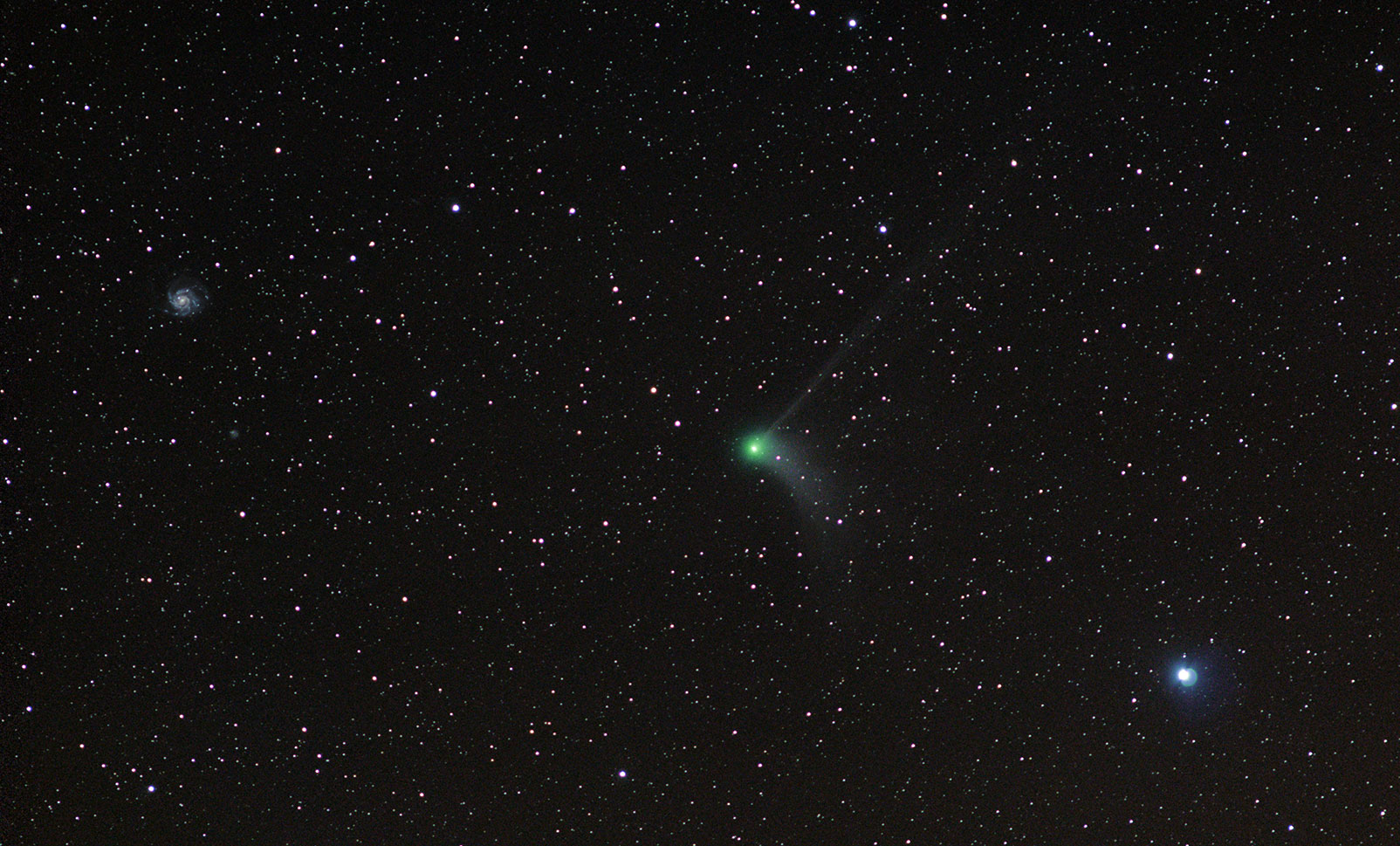Comet Catalina – C/2013 US10
 I finally had a chance to photograph Comet Catalina after what seems like a solid month of cloud. By chance this happened to be a night when the comet passed close to the Pinwheel galaxy (M101) forming a brief but beautiful conjunction. Catalina is already an attractive comet, with the delicate ion tail clearly separate from the wide dust tail, with the coma a familiar green colour.
I finally had a chance to photograph Comet Catalina after what seems like a solid month of cloud. By chance this happened to be a night when the comet passed close to the Pinwheel galaxy (M101) forming a brief but beautiful conjunction. Catalina is already an attractive comet, with the delicate ion tail clearly separate from the wide dust tail, with the coma a familiar green colour.
Image details: Nikon D7000, Nikkor 180mm f2.8 at f2.8. 9 minutes (18 x 30 seconds) at iso 1600. Using didymium filter. Stacked with Deep Sky Stacker and tracked with barn door tracker. Temperature: -1c. Elevation: 5m. Time: 00:30 UT.
[ad]
The comet is currently drifting through Ursa Major, making it a perfect target for viewers in the northern hemisphere throughout the night. The live sky map below shows the current position of the comet as it begins journey out of the solar system, never to return!

this is totally amazing, i have made a tracker but could not get pinpoint tracking, some shots are pinpoint, i guess my hand beep coordination is weak , if u allow i can send u the pics or specs and maybe u can help me out, but very nice commet capture and specially the galaxy, can u do the same for M51 plzzzz
Thanks Shoaib. It’s tricky to say what the issue could be without testing it out myself. But the main things to look out for would be: 1) Check for good polar alignment. 2) Make sure tracker is firmly attached to the tripod, and the tripod is on a solid surface, weighed down if possible. 3) If it’s windy outside this can wobble the camera and badly affect shots with longer lenses. 4) Make sure the rubber band which connects the boards isn’t too tight as this can cause stars to show as small circles/semi-circles. You could also try removing it altogether. 5) Make sure the hinge isn’t wobbling in any way. 6) Make sure the pivoting drive bolt rotates freely and is exactly in line with the seating point. Oh, and I did photograph M51 in Spring last year.. Here’s the post!
Hi. Great image. Looking to build one of your trakers and have a few questions. What’s the best way to contact you?
Thanks
Hi Ian – feel free to ask the questions right here as others may find them useful.. I’ll do my best to answer.
Hi
I have one question for the tracker:
You said the hinge to pivot distance should be 274mm.
But when I calculate that (using 1.25 as pitch for a M8 drive bolt), I get 285.68 mm.
Am I missing something?
See also https://blarg.co.uk/astronomy/barn-door-tracker-calculator
Regards Ralf
Hi Ralph, thanks for the comment. The original plans I followed were for an imperial design, so converting to metric could have led to a few errors here and there. To iron out any discrepancies with the calculations or inaccuracies in the build, I manually calibrated the tracker once it had been built by adjusting the timing beeps by 1/25ths of a second until the tracking was spot on over several minutes.
The final result has the main beeps sounding every 4.8 seconds, with the handle doing a full rotation roughly 0.96 times per minute. This tallies up with the site you linked to. But if you have the choice of M8 or M6, I would go for the M6 bolt size as the final results will be quite a lot more accurate.
I’m planning to add a similar calculator to the site at some point, so that will hopefully avoid any confusion in the future! – Nick
Hi Nick
Thanks for the clarifiction. The interesting part of your post for me is “I manually calibrated the tracker…”. Could you explain how you did that? I now built your design and have more issues then I expected. First one is: I thought it would be much easier to adjust the polar alignment. I do not have any finder scope or green laser and so I just used a simple pipe. It’s very hard to find the NCP. So my main issue is: I cannot tell if the poor results are caused by poor alignment or inaccurate rotation.
Can you give some hints how you calibrated the time beeps, respectively how I can find out what is responsible for the poor results (probably both: alignment and beep intervals)
Regards Ralf
PS: Would you be so kind to also answer per mail, because I cannot sense when you answer here, and it’s diffcult to find that blog again after a while.